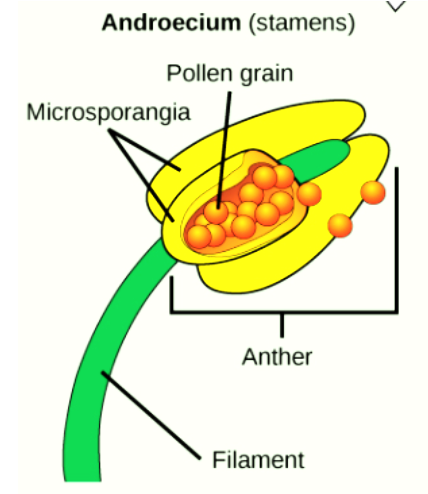
Explain the structure of androecium or stamen.
Answer
572.1k+ views
Hint: Stamen is the male reproductive part of a flower and carpel or pistil is the female reproductive part of a flower. Stamen contains the pollen within the anther. The pollen contains the male gametes of a flower. Carpel contains the ovary within which the ovule is located. The ovule contains the female gametes of a flower.
Complete answer:
The stamen or androecium is known as the male reproductive organ that produces male gamete or pollen. The stamen consists of two parts, anther and filament.
The stamen is made up of filament and anther. Pollen sac and pollen grain are present inside the anther. The filament is a long stalk-like structure in flowers.
The proximal end of the filament is attached to the basal of the flower, which is called the thalamus. The number and length vary species to species.
The anther is a bilobed structure and is also called dithecous. It contains four microsporangia that are separated by sterile tissue. The anther contains two lobes that contain four sides, and each side contains microsporangia.
Microsporangium is the structure that is surrounded by four different layers, including the epidermis, endothecium, middle layer and tapetum. The outer three-layer helps to protect the microsporangium, but the tapetum is the inner layer that helps to nourish the developing pollen grains.

Microspore mother cell is produced in the microsporangium. These cells are diploid; however, they divide through meiosis and produce four haploid microspores. The development of microspore mother cells takes place in male gametophytes, which are further released as pollen.
Pollen grains are the spherical structures that are present inside the anther lobes. The transfer of pollen grains from the anther to stigma is known as pollination.
Note: The female reproductive part of the flower is known as the gynoecium. The gynoecium contains a single pistil and sometimes more than one pistil. The pistil is composed of three parts, including stigma, style and ovary. Stigma is described as the landing platform for pollen grains. Style is a long slim part present below the stigma. The ovary is described as the basal part of the pistil where fertilisation takes place.
Complete answer:
The stamen or androecium is known as the male reproductive organ that produces male gamete or pollen. The stamen consists of two parts, anther and filament.
The stamen is made up of filament and anther. Pollen sac and pollen grain are present inside the anther. The filament is a long stalk-like structure in flowers.
The proximal end of the filament is attached to the basal of the flower, which is called the thalamus. The number and length vary species to species.
The anther is a bilobed structure and is also called dithecous. It contains four microsporangia that are separated by sterile tissue. The anther contains two lobes that contain four sides, and each side contains microsporangia.
Microsporangium is the structure that is surrounded by four different layers, including the epidermis, endothecium, middle layer and tapetum. The outer three-layer helps to protect the microsporangium, but the tapetum is the inner layer that helps to nourish the developing pollen grains.

Microspore mother cell is produced in the microsporangium. These cells are diploid; however, they divide through meiosis and produce four haploid microspores. The development of microspore mother cells takes place in male gametophytes, which are further released as pollen.
Pollen grains are the spherical structures that are present inside the anther lobes. The transfer of pollen grains from the anther to stigma is known as pollination.
Note: The female reproductive part of the flower is known as the gynoecium. The gynoecium contains a single pistil and sometimes more than one pistil. The pistil is composed of three parts, including stigma, style and ovary. Stigma is described as the landing platform for pollen grains. Style is a long slim part present below the stigma. The ovary is described as the basal part of the pistil where fertilisation takes place.
Recently Updated Pages
Master Class 12 Business Studies: Engaging Questions & Answers for Success

Master Class 12 Economics: Engaging Questions & Answers for Success

Master Class 12 English: Engaging Questions & Answers for Success

Master Class 12 Maths: Engaging Questions & Answers for Success

Master Class 12 Social Science: Engaging Questions & Answers for Success

Master Class 12 Chemistry: Engaging Questions & Answers for Success

Trending doubts
What are the major means of transport Explain each class 12 social science CBSE

Which are the Top 10 Largest Countries of the World?

Draw a labelled sketch of the human eye class 12 physics CBSE

Explain sex determination in humans with line diag class 12 biology CBSE

The pH of the pancreatic juice is A 64 B 86 C 120 D class 12 biology CBSE

Give 10 examples of unisexual and bisexual flowers




